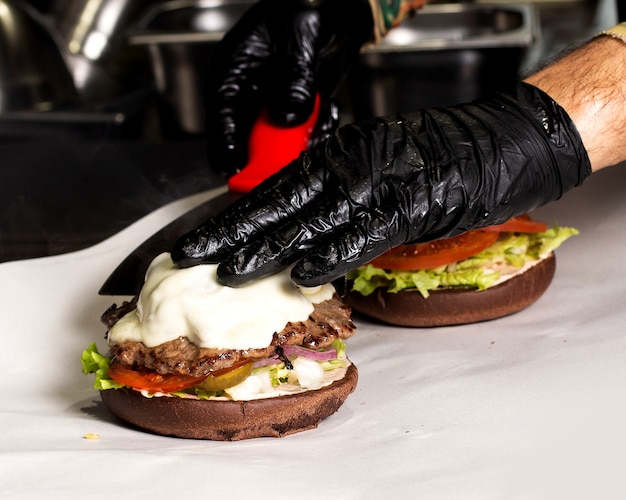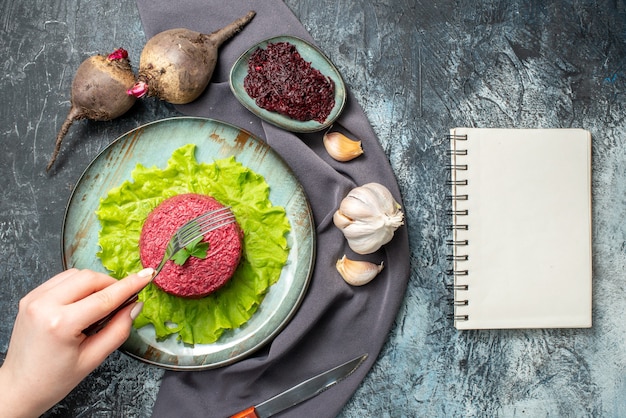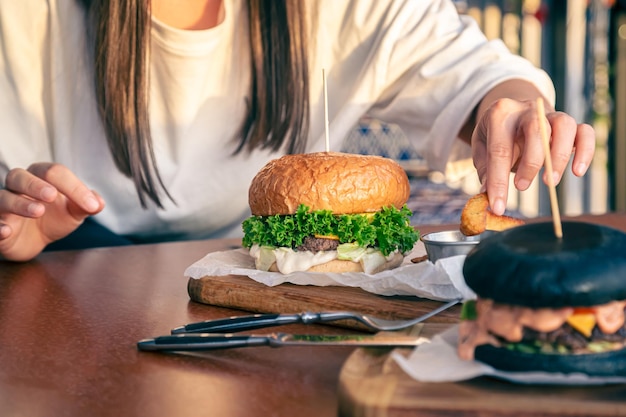Ah, the burger. A culinary masterpiece, a symphony of flavors, a symbol of pure, unadulterated joy. But let's be honest, a burger is only as good as its patty, and that patty, my friends, is all about temperature. It's not just about safety, it's about unlocking the full potential of that delicious hunk of meat. So, grab a comfy chair, a cold drink, and let's delve into the world of the perfect burger temperature, together.
(Part 1) The Science of a Perfect Burger: More Than Just a Feeling

I've always been a burger fanatic, obsessed with finding that perfect bite – the kind that melts in your mouth, leaving behind a satisfying symphony of flavors and textures. Over the years, I've learned that it's not just about the ingredients or the fancy toppings, it's about the science. The science of heat, of proteins changing, of moisture evaporating, and how all these factors come together to create a truly remarkable burger experience.
The Danger Zone: Where Bacteria Thrive
Think of it this way: bacteria are like little party animals who love to hang out in the "danger zone" - that temperature range between 40°F and 140°F. If you leave your burger out on the counter for too long, these little critters will have a field day. It's a recipe for a disastrous meal and a potentially unpleasant aftermath. That's why getting your burger up to a safe temperature quickly and keeping it there is so important.
The Sweet Spot: The Goldilocks of Burger Temperatures
The general consensus is to aim for an internal temperature of 160°F. It's the safe zone, the point where the proteins have been sufficiently cooked, making it safe for consumption. But here's the thing: for those who crave the ultimate burger experience, there's a secret, a sweet spot - a temperature around 155°F. At this point, the meat is still juicy, flavorful, and retains that glorious slight pinkness in the center. It's the perfect balance of safety and incredible taste, a true burger nirvana.
(Part 2) The Doneness Spectrum: A Journey of Burger Flavors

Don't let the term "doneness" intimidate you. It's simply a way to describe the level of cooking, and each level brings a unique flavor profile to the table. It's a matter of personal preference, but it's good to understand the nuances of each level:
Rare: 125°F - 130°F
For the adventurous burger lover, rare is a bold choice. The center is vividly red, almost raw, and the texture is incredibly soft. It's for those who enjoy the primal flavor of raw meat, a true taste of the wild.
Medium Rare: 130°F - 140°F
This is a popular choice, striking a balance between the juicy tenderness of rare and the slight browning of medium. It has a pleasing pink center, offering a delightful contrast of textures and flavors.
Medium: 140°F - 150°F
This is the most common level of doneness, appealing to those who prefer a bit more cooked through. The center is slightly brown, with just a hint of pink remaining. It's a safe and reliable option for those who want a balanced burger experience.
Medium Well: 150°F - 160°F
This level is mostly brown, with just a small pink center peeking through. It's a step closer to well-done but still retains some juiciness and tenderness.
Well-Done: 160°F and above
This is the most cooked level, the safest option, but it's often dry and tough. The center is completely brown, lacking the juicy character of the lower levels. It's a good choice for those who prefer a more cooked texture.
(Part 3) Tools of the Trade: Temperature Champions

You can't just eyeball the perfect burger temperature. You need a trusty sidekick, a tool that can give you a precise reading. Here's a breakdown of the most essential tools for the burger enthusiast:
meat thermometer: The Essential Ally
This is a must-have for any serious burger cook. There are different types, but I recommend a digital one with a probe that can be inserted into the thickest part of the patty. This allows for a quick and accurate temperature reading.
Thermapen: The Speed Demon of Temperature Measurement
If you're a burger fanatic who wants the ultimate temperature control, a Thermapen is a worthy investment. It's lightning fast, incredibly accurate, and a true game changer for achieving perfect doneness.
Instant-Read Thermometer: The Handy Companion
This smaller, portable thermometer is perfect for grilling or cooking on the stovetop. It's not as accurate as a Thermapen, but it's still a useful tool for getting a rough estimate of your burger's internal temperature.
(Part 4) Cooking Methods: Finding Your Burger Groove
Now, the fun part: the cooking! Each method brings its own unique qualities and challenges, but the goal is always the same: to cook your burger to the perfect temperature.
Grilling: The Classic Approach
Grilling is the quintessential way to cook a burger, creating those iconic grill marks and a smoky aroma that's sure to get your mouth watering. But it requires a bit of finesse. Use medium-high heat, watch your burgers closely, and flip them once or twice for even cooking. And remember, always use a meat thermometer to ensure your burger reaches the desired internal temperature.
Pan-Frying: The Versatile Method
A cast iron skillet is a versatile workhorse, and pan-frying is a great option when you don't have a grill. Make sure your skillet is good and hot before adding your burgers. This prevents sticking and promotes a nice sear. Keep an eye on the temperature and flip your burgers when they've achieved a crispy crust. Remember, a meat thermometer is your best friend for ensuring perfect doneness.
Oven Baking: The Hands-Off Option
For a more laid-back approach, try baking your burgers in the oven. It's a great option for those who want to avoid the constant flipping and fuss of grilling. Preheat your oven to 400°F, place your burgers on a baking sheet, and cook for 15-20 minutes, or until they reach your desired internal temperature. Use a meat thermometer to ensure safety and perfection.
Air Fryer: The Speed Demon of burger cooking
For a quick and easy cooking method, the air fryer is a modern marvel. It cooks burgers quickly and evenly, achieving a crispy exterior and a juicy interior. Preheat your air fryer to 400°F, cook your burgers for 8-10 minutes, or until they reach your desired internal temperature. Remember to use a meat thermometer for a safe and delicious result.
(Part 5) The Burger Beyond the Patty: Toppings and Assembly
Of course, it's not just about the patty. The toppings play a crucial role in the overall burger experience, adding layers of flavor, texture, and visual appeal. And, believe it or not, they can affect the final temperature too.
The Impact of Toppings
Cheese, bacon, and other toppings can affect the internal temperature of your burger. If you're piling on the cheese, it will melt and add a bit of heat. Bacon, on the other hand, will already be cooked, so it won't significantly affect the temperature. Keep these factors in mind when adjusting your cooking time.
The Art of Assembly
The assembly is where your burger masterpiece truly comes to life. The order of your toppings can influence the final taste and texture. I always start with the cheese, allowing it to melt and create a delicious sauce that binds everything together. Then, I add the lettuce, tomato, onion, and pickles, creating a refreshing and crunchy contrast. Finally, I top it off with the bun.
But remember, this is just my personal preference. Experiment and discover your own unique assembly technique. The beauty of burgers is in their endless possibilities.
(Part 6) Resting: The Art of Patience
After cooking, don't be tempted to dive in right away. Give your burger a few minutes to rest. This allows the juices to redistribute throughout the patty, resulting in a juicier and more flavorful experience. I usually let my burgers rest for 5-10 minutes before serving. This gives the internal temperature time to stabilize, and prevents the juices from running out when you cut into it.
(Part 7) Burger Temperature and Safety: A Culinary Must
The most important aspect of all this is safety. It's essential to make sure that your burger is cooked to a safe internal temperature to avoid foodborne illnesses. Here's a quick reminder of the safe internal temperatures for different types of meat:
| Meat | Safe Internal Temperature |
|---|---|
| Beef, pork, veal, and lamb | 145°F (63°C) |
| ground beef, pork, veal, and lamb | 160°F (71°C) |
| Poultry | 165°F (74°C) |
(Part 8) Burger Temperature and Preference: The Personal Touch
Remember, the perfect burger temperature is subjective. It's all about finding what you like best. Some people prefer a well-done burger, while others prefer a medium-rare burger. There's no right or wrong answer. Embrace your individual taste and don't be afraid to experiment.
Explore different levels of "doneness," try out various cooking methods, and discover what brings you the ultimate burger satisfaction. The key is to have fun, to enjoy the process, and to find your perfect burger temperature.
FAQs
1. What happens if my burger is undercooked?
If your burger is undercooked, it might contain harmful bacteria that can cause food poisoning. It's crucial to cook your burger to a safe internal temperature of at least 160°F for ground meat. This ensures that the bacteria have been killed, making your burger safe to eat. Don't take any chances with your health!
2. Can I cook a burger to rare or medium rare?
Yes, you can cook a burger to rare or medium rare, but it's important to be aware of the risks involved. If you choose to cook your burger to a lower temperature, make sure to use fresh, high-quality meat from a reliable source. Cook it thoroughly, and always wash your hands and surfaces thoroughly after handling raw meat. It's all about minimizing the risk and enjoying a delicious burger responsibly.
3. What's the best way to tell if a burger is cooked through?
The best way to tell if a burger is cooked through is to use a meat thermometer. Insert the thermometer into the thickest part of the burger and make sure it reaches the desired internal temperature. This is the most accurate method to ensure both safety and deliciousness.
4. How can I keep my burger juicy?
There are a few tricks to keep your burger juicy. First, use a meat thermometer to avoid overcooking. Overcooked burgers become dry and tough, so finding that sweet spot of temperature is crucial. Second, let the burger rest for a few minutes after cooking to allow the juices to redistribute throughout the patty. Finally, use a bun that can hold up to the juices without getting soggy. A good bun is essential for a balanced and delicious burger experience.
5. What if I don't have a meat thermometer?
If you don't have a meat thermometer, you can try to gauge the doneness of your burger by pressing on it. A well-done burger will be firm to the touch, while a medium-rare burger will be soft and springy. But this method is not as accurate as using a meat thermometer. If you're serious about burgers, invest in a good thermometer - it's worth every penny.
Everyone is watching

Prime Rib Roast Cooking Time Chart: Per Pound Guide
Cooking TipsPrime rib roast. Just the name conjures images of lavish dinners, crackling fires, and hearty laughter. It’s ...

How Long to Bake Potatoes in the Oven (Perfect Every Time)
Cooking TipsBaked potatoes are a staple in my kitchen. They're incredibly versatile, delicious, and surprisingly easy to m...

Perfect Rice Every Time: The Ultimate Guide to Cooking Rice
Cooking TipsAs a self-proclaimed foodie, I've always been a bit obsessed with rice. It's the foundation of countless cuisi...

The Ultimate Guide to Cooking Asparagus: Tips, Techniques, and Recipes
Cooking TipsAsparagus. The mere mention of this spring delicacy conjures up images of vibrant green spears, crisp and burs...

Ultimate Guide to Cooking the Perfect Thanksgiving Turkey
Cooking TipsThanksgiving. Just the word conjures up images of overflowing tables laden with delicious food, the scent of r...
